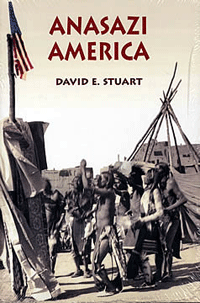
- Anasazi America
- University of New Mexico Press
In the Americans' current age of anxiety, comparisons with Rome are easy and numerous: Chalmers Johnson's Nemesis, recently reviewed here, is only one of many. Some writers, like Jared Diamond, consider ecological downfall a consequence of political failure. Like the Greenland Norse and the Easter Islanders, they argue, we in the industrial nations may be too locked into our culture to adapt to changes we ourselves create.
But another lost civilization, right here in North America, offers not just examples of failure to avoid but also of success to imitate. Anasazi America, by David E. Stuart, an archaeologist specializing in the Southwest, offers an excellent introduction to this oh-so-relevant history.
The Anasazi were a cluster of related tribes in New Mexico who began to adopt agriculture at about the time that Rome was falling. I had always thought of them as a mysterious people who built cities and then vanished. But as Stuart makes clear, archaeologists have amassed a great deal of forensic evidence about the Anasazi -- and we know even more about their descendants, the Pueblo Indians.
History in their bones
The history of the Anasazi is written in the tree rings of their roof beams and the bones of their dead. The roof beams record the wet and dry years since their earliest settlements. Similarly, their bones and teeth record years of plenty and years of famine.
Between 700 and 1000 AD, small farming communities grew and expanded across northwest New Mexico and the adjacent areas of Arizona, Utah, and Colorado. By the end of the 10th century, an estimated 10,000 farmsteads were operating across an area the size of Scotland. Then, starting around 1020, something remarkable happened in the Chaco Canyon area of New Mexico. The "Chaco phenomenon" saw the sudden evolution of "great houses," urban centres that drew on the food and goods produced by their nearby small farms.
The great houses created trade links for both essentials and luxuries, including macaws imported from Mexico and abalone shells from California. Four hundred miles of roads linked the burgeoning communities. But surprisingly, the society had no warrior class.
Ritual rule
Stuart argues that the great-house elites sustained themselves not by force but by religion and ritual. The Anasazi were good farmers, ready to experiment with different food plants and different farmlands. But they were at the mercy of the climate, and the great houses supplied two key services.
First, their rituals purported to ensure that rain would fall in July, when the cornfields most needed it most. And, for almost a century, the water generally came when it was needed. Second, if the crops did fail in some places, the great houses were able to supply food and seed from more successful spots. In return, for these services, the farmers gave their scanty surpluses to the great houses.
But in 1090, when the Normans were consolidating their hold on Saxon England, the rains failed in New Mexico. The long drought cost the elites much of their prestige, which they answered with more and bigger rituals. When, by 1100 the rains returned, more great houses appeared in more far-flung regions, and more roads, and still more wealth went into the rituals.
The income gap
Wealth also went into supporting the great-house elites. Anasazi life, even at its best, was a harsh one. Almost half the ordinary farmers' children died in infancy, and most farmers themselves were dead by 45. Their teeth reveal bouts of childhood malnutrition, and the osteoporosis in their bones shows the lack of other nutrients in a life of brutally hard work.
But the great-house families lost fewer children. They were on average 5 cm taller than the farmers, and they lived longer. That gap in income and health persisted until the system broke down for good.
The rains failed again in the early 12th century. As a result, farmers moved away from the great houses to the upland, searching for rain. The first to leave did well for a time; then a dark age fell.
Settlements became fortified, but still succumbed to attack. Evidence suggests that between 1120 and 1140, 60 per cent of all adults and 40 per cent of all children died violently. Stuart estimates that by the end of the 13th century, the Anasazi population was only a quarter of what it had been 200 years before.
From power to efficiency
Out of this dark age emerged the "Pueblo IV," a culture strikingly different from that of its Chacoan ancestors. The Chacoans had been what Stuart calls a "power" culture, relying on extensive farming and trade to cover the losses when a crop failed.
By 1400, power had yielded to efficiency. While trade continued, it was minor compared to the old days. Each community was now self-sufficient, and drew on resources from diverse ecosystems within its control. It was unified and egalitarian, and produced necessities rather than luxuries. Life was still hard and short, but the Pueblos now at least were able to deal with the vagaries of weather.
Significantly, most of the Pueblo IV communities were unfortified. While they suffered occasional raids from Plains tribes, Pueblo communities were no longer threats to one another. In fact they even worked in concert when necessary, as when they arose and expelled the Spanish in 1680. (The Spanish returned in 1692 only because the Pueblos were weakened by European disease.)
A portent of the future
Writing in the late 1990s, Stuart drew some persuasive analogies between the Chacoans and modern America's power culture, with its aggressively expansionist trade, exuberant economy, and growing gap between rich and poor.
Stuart also points out that today's Pueblos keep their rituals and language alive not to entertain tourists but to sustain the values of their efficient culture. They know what happens to power cultures, and they see America as dangerously fragile.
Comparing America's empire with those of Rome and Britain is easy and often helpful. But Anasazi America is more compelling. The Anasazi showed that imperial collapse and a dark age really can happen here. Their descendants have proved that a lost civilization can find itself again and endure for centuries. And that is a very encouraging thought.




